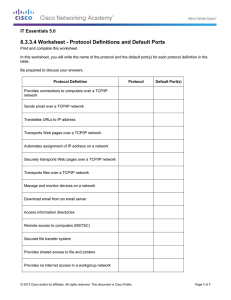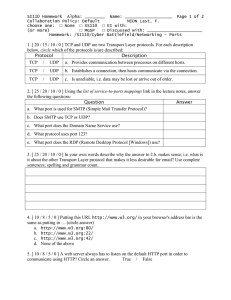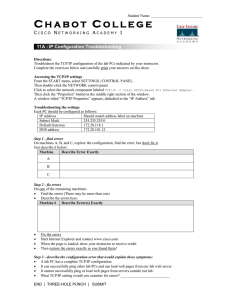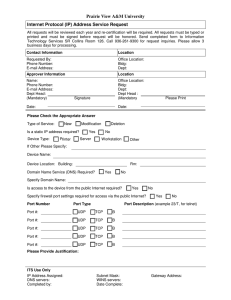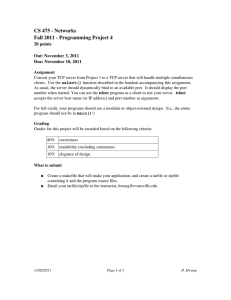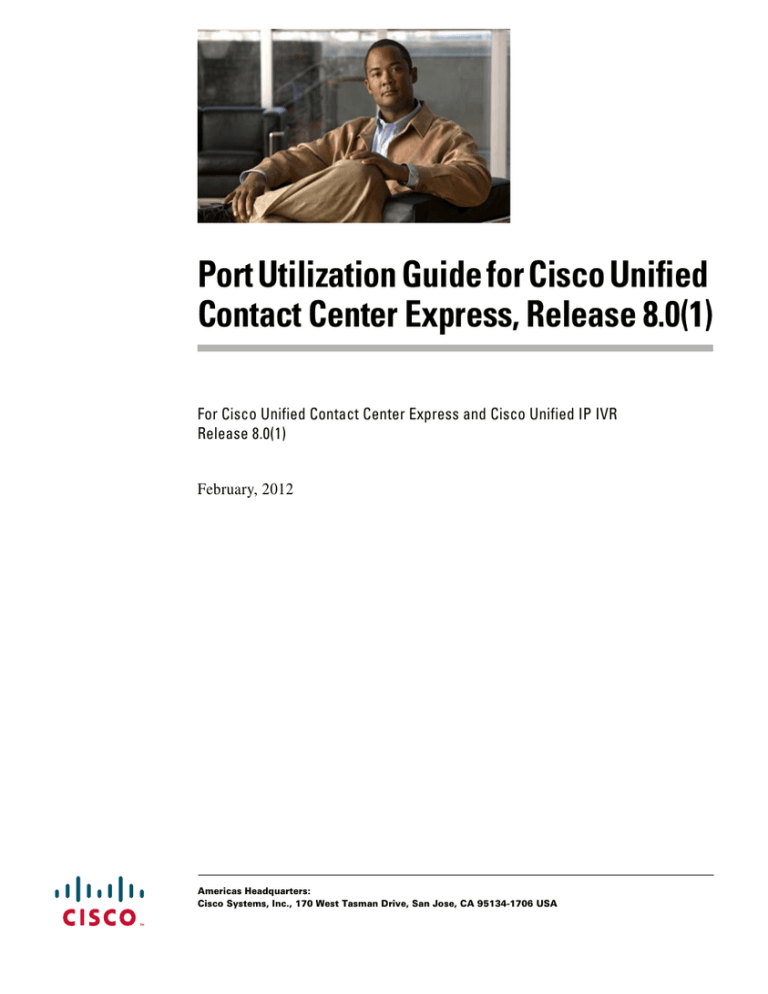
Port Utilization Guide for Cisco Unified
Contact Center Express, Release 8.0(1)
For Cisco Unified Contact Center Express and Cisco Unified IP IVR
Release 8.0(1)
February, 2012
Americas Headquarters:
Cisco Systems, Inc., 170 West Tasman Drive, San Jose, CA 95134-1706 USA
Contents
Contents
This document contains the following topics:
•
Overview, page 2
•
Intended Audience, page 2
•
Related Documentation, page 3
•
Port Utilization Table Column Definition, page 3
•
Cisco Unified CCX Port Utilization, page 4
•
Cisco Unified IP IVR Port Utilization, page 7
•
Cisco Agent/Supervisor Desktop Port Utilization, page 10
•
Static Client Ports for Non-Citrix/MTS Environment, page 11
•
Obtain Additional Support and Documentation, page 12
•
Documentation Feedback, page 12
Overview
This document provides a list of the TCP and UDP ports used by the Cisco Unified
Contact Center Express 8.0(1) application, including Cisco Unified IP IVR and
Cisco Unified CCX platform. Port listings are presented in a tabular format.
Intended Audience
This guide is intended for Cisco Unified Communications network
administrators.
Port Utilization Guide for Cisco Unified Contact Center Express, Release 8.0(1)
2
Related Documentation
Related Documentation
•
For Cisco Unified ICME/CCE port utilization information, see the Port
Utilization Guide for Cisco Unified ICM/IPCC here:
http://www.cisco.com/en/US/products/sw/custcosw/ps1001/products_install
ation_and_configuration_guides_list.html
•
For Cisco Unified CCX design information, see the Solution Reference
Network Design for Cisco Unified Contact Center Express and Cisco Unified
IP IVR here:
http://www.cisco.com/en/US/products/sw/custcosw/ps1846/products_imple
mentation_design_guides_list.html
•
For a complete list of terms used in Cisco Unified CCX and Cisco Unified IP
IVR, see the following URL:
http://www.cisco.com/en/US/products/sw/custcosw/ps1846/prod_technical_
reference_list.html
Port Utilization Table Column Definition
The columns in the Port Utilization tables in this document describe the following:
•
Purpose. The service for which a particular port is used by the server.
•
Application. This is the name of the process that is expected to provide the
service using a port.
•
Network Protocol. It is a lower level transport mechanism that is unaware of
what is being transported over a netwrok. TCP and UDP are the two transport
protocols used here.
•
Protocol. It is a higher application level transport mechanism that defines the
semantics of the messages being transported over a network. If you see TCP
as the protocol, it means that the protocol is proprietary.
•
Destination Port / Listener. A numeric identifier that the Internet transport
protocol uses to distinguish among multiple, simultaneous connections to a
single destination host.
•
Remote Device. The name of the devices that connect to the listed port.
•
Source Port. The port using which the remote device connects to the listed
port.
Port Utilization Guide for Cisco Unified Contact Center Express, Release 8.0(1)
3
Cisco Unified CCX Port Utilization
Cisco Unified CCX Port Utilization
Here is a list of ports that are used in Cisco Unified CCX 8.0(1) (see Table 1).
Table 1
Cisco Unified CCX Port Utilization
Destination
Port /
Listener
Application /
Process
7
System Service
Protocol
Network
Protocol
Remote Device
TCP
Editor
Source
Port
Purpose
- Echo for Editor
- ICM Controller
22
System Service
80, 8080
Tomcat
TCP
SFTP and SSH access
TCP
Web access
123
System Service
UDP
Network time sync
161
SNMP Agent
SNMP
UDP
Provide services for
SNMP-based management
applications
1090
AON
Management
Console (AMC)
Service
RMI
TCP
Intra-Cluster
communication1 only
Provide RTMT data collecting,
logging and alerting
functionalities (AMC RMI
Object Port)
1099
AON
Management
Console (AMC)
Service
RMI
TCP
Intra-Cluster
communication only
Provide RTMT data collecting,
logging and alerting
functionalities (AMC RMI
Registry Port)
1500
DBMON
TCP
This is the port where the IDS
engine listens for DB clients
1501
DBMON
TCP
- This is an alternate port to bring
up a second instance of IDS
during upgrade.
HTTP
- Localhost traffic only
1504
Informix
Dynamic Server
(IDS)
1515
DBL RPC
XML
TCP
External process like
HRC, WallBoard
Client, External DB
clients (like Squirrel or
others for custom
reporting) can connect
Unified CCX database port
TCP
Intra-Cluster
communication only
DBL RPC, this is used during
installation to set up IDS
replication between nodes
Port Utilization Guide for Cisco Unified Contact Center Express, Release 8.0(1)
4
Cisco Unified CCX Port Utilization
Destination
Port /
Listener
Application /
Process
1990
CVD
TCP
CVD of other node in
cluster
Bootstrap adaptor listening for
configuration requests
1994
Unified CCX
Cluster View
Daemon (CVD)
TCP
CAD Services
CAD/CSD components
communicate with CVD
1996
CVD
UDP
CVD of other node in
cluster
Heartbeats between CVDs in the
cluster
2555
Real-Time
Information
Server (RIS)
Data Collector
service (RISDC)
TCP
Intra-Cluster
communication only
Connect to other RISDC
services in the cluster to provide
cluster-wide real-time info
2556
RISDC
TCP
Intra-Cluster
communication only
Allowed RIS client connection
to retrieve real-time info
4040
Disaster
Recovery System
(DRS)
TCP
4160
CVD
TCP
CVD of other node in
cluster
Jini lookup service TCP port
4160
CVD
UDP
CVD of other node in
cluster
Jini lookup service UDP port
5007
System Service
5062
Unified
Communications
Manager Express
(Unified CME)
TCP
Unified CME host
Unified CME host
communication with Unified
CCX
6293, 8080
True Update
TCP
CAD/CSD
CAD/CSD true update
6295
CVD
TCP
CVD of other node in
cluster
Bootstrap HTTPD service port
6999
CVD
TCP
Engine, Tomcat,
CVD, and Editor
RMI Port
8001
DBMON
TCP
Intra-Cluster
communication only
DB change notification port
Protocol
SOAP
CN
Network
Protocol
Remote Device
Source
Port
Purpose
DRF master agent server port
accepts connections from local
agent GUI and CLI
TCP
SOAP Monitor - a
troubleshooting tool for SOAP
infrastructure
Port Utilization Guide for Cisco Unified Contact Center Express, Release 8.0(1)
5
Cisco Unified CCX Port Utilization
Destination
Port /
Listener
Application /
Process
Protocol
Network
Protocol
Remote Device
8080, 8443
Tomcat
HTTPS
TCP
Client Browser
Source
Port
Purpose
- Client browser trying to access
any of the Administration
interfaces or User Options
interface
- Web services client using
RTMT and mobile supervisor
applications
8443
Tomcat
SOAP
TCP
DB access via SOAP; Tomcat
forwards the SOAP request to
AXL
8500
IPSec Manager
daemon
Proprietary
UDP
Cluster replication of platform
data (hosts) certificates etc.
8500
IPSec Manager
daemon
Proprietary
TCP
Connectivity testing
9080
Engine
TCP
- Clients trying to access HTTP
triggers or documents / prompts
/ grammars
- Tomcat instance used by
Unified CCX engine
12028
Unified CCX
Engine
TCP
CTI Server
24576 ~
32767
Cisco IP Voice
Media Streaming
application
UDP
- Audio media streaming Kernel streaming device driver
32768 ~
61000
TCP
Generic ephemeral TCP ports2
32768 ~
61000
UDP
Generic ephemeral UDP ports3
65535
RTP RTCP
TVS
JTAPI Client
TCP
QBE
TCP
Trust Verification Service
Unified CM
2748
Provide services to CTI applications
1. Intra-Cluster communication in the table represents communication between Unified CCX servers in a cluster.
2. TCP Ephemeral ports are used to accept connections during Java RMI communication. Java RMI clients know which port it
need to connect, because RMI first connects to RMI Registry (well known port - 6999) and get the information which
ephemeral port client need to connect to. AppAdmin, Engine & CVD use RMI communication in CCX/IP-IVR, so TCP
ephemeral port range is opened up for intra-cluster communication between these processes.
3. UDP Ephemeral ports are used to receive audio/video RTP streams; so UDP Ephemeral port range is opened for incoming
connections for streaming RTP media from CTI ports.
Port Utilization Guide for Cisco Unified Contact Center Express, Release 8.0(1)
6
Cisco Unified IP IVR Port Utilization
Cisco Unified IP IVR Port Utilization
Here is a list of ports that are used in Cisco Unified IP IVR 8.0(1) (see Table 2).
Table 2
Cisco Unified IP IVR Port Utilization
Destination
Port /
Listener
Application /
Process
7
System Service
Protocol
Network
Protocol
Remote Device
TCP
Editor
Source
Port
Purpose
- Echo for Editor
- ICM Controller
22
System Service
80, 8080
Tomcat
TCP
SFTP and SSH access
TCP
Web access
123
System Service
UDP
Network time sync
161
SNMP Agent
SNMP
UDP
Provide services for
SNMP-based management
applications
1090
AON
Management
Console (AMC)
Service
RMI
TCP
Intra-Cluster
communication1 only
Provide RTMT data collecting,
logging and alerting
functionalities (AMC RMI
Object Port)
1099
AON
Management
Console (AMC)
Service
RMI
TCP
Intra-Cluster
communication only
Provide RTMT data collecting,
logging and alerting
functionalities (AMC RMI
Registry Port)
1500
DBMON
TCP
This is the port where the IDS
engine listens for DB clients
1501
DBMON
TCP
- This is an alternate port to bring
up a second instance of IDS
during upgrade.
HTTP
- Localhost traffic only
1504
Informix
Dynamic Server
(IDS)
1515
DBL RPC
XML
TCP
External process like
HRC, WallBoard
Client, External DB
clients (like Squirrel or
others for custom
reporting) can connect
Unified IP IVR database port
TCP
Intra-Cluster
communication only
DBL RPC, this is used during
installation to set up IDS
replication between nodes
Port Utilization Guide for Cisco Unified Contact Center Express, Release 8.0(1)
7
Cisco Unified IP IVR Port Utilization
Destination
Port /
Listener
Application /
Process
1990
CVD
TCP
CVD of other node in
cluster
Bootstrap adaptor listening for
configuration requests
1994
Unified IP IVR
Cluster View
Daemon (CVD)
TCP
CAD Services
CAD/CSD components
communicate with CVD
1996
CVD
UDP
CVD of other node in
cluster
Heartbeats between CVDs in the
cluster
2555
Real-Time
Information
Server (RIS)
Data Collector
service (RISDC)
TCP
Intra-Cluster
communication only
Connect to other RISDC
services in the cluster to provide
cluster-wide real-time info
2556
RISDC
TCP
Intra-Cluster
communication only
Allowed RIS client connection
to retrieve real-time info
4040
Disaster
Recovery System
(DRS)
TCP
4160
CVD
TCP
CVD of other node in
cluster
Jini lookup service TCP port
4160
CVD
UDP
CVD of other node in
cluster
Jini lookup service UDP port
5000
Unified IP IVR
Engine
TCP
Unified ICM
Using this port Unified ICM
Subsystem listens to
GED-125Clients
5007
System Service
6293, 8080
True Update
TCP
CAD/CSD
CAD/CSD true update
6295
CVD
TCP
CVD of other node in
cluster
Bootstrap HTTPD service port
6999
CVD
TCP
Engine, Tomcat,
CVD, and Editor
RMI Port
8001
DBMON
TCP
Intra-Cluster
communication only
DB change notification port
Protocol
SOAP
CN
Network
Protocol
Remote Device
Source
Port
DRF master agent server port
accepts connections from local
agent GUI and CLI
TCP
SOAP Monitor - a
troubleshooting tool for SOAP
infrastructure
Port Utilization Guide for Cisco Unified Contact Center Express, Release 8.0(1)
8
Purpose
Cisco Unified IP IVR Port Utilization
Destination
Port /
Listener
Application /
Process
Protocol
Network
Protocol
Remote Device
8080, 8443
Tomcat
HTTPS
TCP
Client Browser
Source
Port
Purpose
- Client browser trying to access
any of the Administration
interfaces or User Options
interface
- Web services client using
RTMT and mobile supervisor
applications
8443
Tomcat
SOAP
TCP
DB access via SOAP; Tomcat
forwards the SOAP request to
AXL
8500
IPSec Manager
daemon
Proprietary
UDP
Cluster replication of platform
data (hosts) certificates etc.
8500
IPSec Manager
daemon
Proprietary
TCP
Connectivity testing
9080
Engine
TCP
- Clients trying to access HTTP
triggers or documents / prompts
/ grammars
- Tomcat instance used by
Unified IP IVR engine
24576 ~
32767
UDP
- Audio media streaming Kernel streaming device driver
32768 ~
61000
TCP
Generic ephemeral TCP ports2
32768 ~
61000
UDP
Generic ephemeral UDP ports3
TCP
Trust Verification Service
65535
Cisco IP Voice
Media Streaming
application
RTP RTCP
TVS
JTAPI Client
QBE
TCP
Unified CM
2748
Provide services to CTI
applications
1. Intra-Cluster communication in the table represents communication between Unified IP IVR servers in a cluster.
2. TCP Ephemeral ports are used to accept connections during Java RMI communication. Java RMI clients know which port it
need to connect, because RMI first connects to RMI Registry (well known port - 6999) and get the information which
ephemeral port client need to connect to. AppAdmin, Engine & CVD use RMI communication in CCX/IP-IVR, so TCP
ephemeral port range is opened up for intra-cluster communication between these processes.
3. UDP Ephemeral ports are used to receive audio/video RTP streams; so UDP Ephemeral port range is opened for incoming
connections for streaming RTP media from CTI ports.
Port Utilization Guide for Cisco Unified Contact Center Express, Release 8.0(1)
9
Cisco Agent/Supervisor Desktop Port Utilization
Cisco Agent/Supervisor Desktop Port Utilization
Here is a list of ports that are used by Cisco Agent Desktop (CAD) or Cisco
Supervisor Desktop (CSD) applications or services to communicate with Cisco
Unified CCX 8.0(1) (see Table 3 and Table 4).
Note
These ports are not opened for Cisco Unified IP IVR deployment.
The remote devices for these ports are all CAD / CSD / CAD-BE (CAD-Business
Edition) and the source ports are from the ephemeral port range of the connecting
device.
Table 3
Cisco Agent / Supervisor Desktop Port Utilization
Port
Application/ Process
Network Protocol
Purpose
3000
LRMSvc
TCP
Licensing and Resource Manager Service
3001
CallChatSvc
TCP
Call / Chat Service - CORBA
3002
CallChatSvc
TCP
Call / Chat Service - VPN
3003
RASCALSvc
TCP
Recording and Statistics Service
3004
EntSvc
TCP
Enterprise Service
3103
EntSvc
TCP
Enterprise Service - Chat
3006
EEMSvc
TCP
Agent E-Mail Service
3007
LDAPMon
TCP
LDAP Monitor Service
3008
SyncSVC
TCP
Sync Service
3009
RecSvC
TCP
Recording and Playback Service - CORBA
3010
RecSvc
TCP
Recording and Playback Service - VPN
3011
VoIP
TCP
VoIP Monitor Service - CORBA
3012
VoIP
TCP
VoIP Monitor Service - VPN
3013
BIPPA
TCP
Browser and IP Phone Agent Service - CORBA
3014
BIPPA
TCP
Browser and IP Phone Agent Service - TCP
3016, 38983
LDAP
TCP
Open LDAP
3017
LDAP
TCP
Open LDAP
3102
BIPPA
TCP
Browser and IP Phone Agent Service - Chat
3500:3700
Rec
UDP
Recording and Playback Service - RTP
Port Utilization Guide for Cisco Unified Contact Center Express, Release 8.0(1)
10
Cisco Agent/Supervisor Desktop Port Utilization
Port
Application/ Process
Network Protocol
Purpose
8443
HTTPS
TCP
SOAP between CAD client and Unified CM
65432
LRMSvc
TCP
Licensing and Resource Manager Upgrade Service
There are few ports that are listening on Cisco Desktop clients. This applies to
non-Citrix/MTS environments only and does not include other connections that
are made with ephemeral ports. Table 4 provides information regarding these
fixed client ports.
Table 4
Port
Static Client Ports for Non-Citrix/MTS Environment
Process
Network
Protocol
Port Utilization
Comments
Cisco Agent Desktop
59015
eem applet
TCP
Cisco Agent Desktop
Will be any available port in Citrix. Client is
local Cisco Agent Desktop (does not cross the
network)
59020
desktop mon /
chat
TCP
Cisco Supervisor Desktop/
Cisco Desktop Base Services
Will be any available port in Citrix
58000
ipc receive event
UDP
Custom application
Provides an interface to control Agent Desktop
Note: It can be changed via Cisco Desktop
Workflow Administration
Ephemeral
Chat presence
TCP and
UDP
Chat presence service
Will be any available port in Citrix; Cisco
Unified Presence (CUP) server listens on 5060
(Default for SIP and configurable in CUP
server)
Cisco Supervisor Desktop
59021
chat
TCP
Cisco Desktop Base Services
Will be any available port in Citrix
59010
voip
UDP
Cisco Desktop VoIP Monitor
Service (SPAN-based
monitoring), Cisco Agent
Desktop (desktop monitoring)
Will be any available port in Citrix
playback
UDP
Cisco Desktop Recording
Service
Will be any available port in Citrix
Chat presence
TCP and
UDP
Chat presence service
Will be any available port in Citrix; Cisco
Unified Presence (CUP) server listens on 5060
(Default for SIP and configurable in CUP
server)
59012
59014
59016
Ephemeral
Port Utilization Guide for Cisco Unified Contact Center Express, Release 8.0(1)
11
Obtain Additional Support and Documentation
Obtain Additional Support and Documentation
For information on obtaining support, obtaining additional documentation,
providing documentation feedback, security guidelines, and also recommended
aliases and general Cisco documents, see the monthly What's New in Cisco
Product Documentation, which also lists all new and revised Cisco technical
documentation, at:
http://www.cisco.com/en/US/docs/general/whatsnew/whatsnew.html
Subscribe to the What’s New in Cisco Product Documentation as a Really Simple
Syndication (RSS) feed and set content to be delivered directly to your desktop using
a reader application. The RSS feeds are a free service and Cisco currently supports
RSS version 2.0.
Documentation Feedback
You can provide comments about this document by sending an email to the
following address:
ccbu_docfeedback@cisco.com
We appreciate your comments.
Port Utilization Guide for Cisco Unified Contact Center Express and Cisco Unified IP IVR, Release 8.0(1)
Cisco and the Cisco Logo are trademarks of Cisco Systems, Inc. and/or its affiliates in the U.S. and other countries.
A listing of Cisco's trademarks can be found at www.cisco.com/web/siteassets/legal/trademark.html. Third party
trademarks mentioned are the property of their respective owners. The use of the word partner does not imply a
partnership relationship between Cisco and any other company. (1005R)
© 2011 Cisco Systems, Inc. All rights reserved.
Port Utilization Guide for Cisco Unified Contact Center Express, Release 8.0(1)
12

